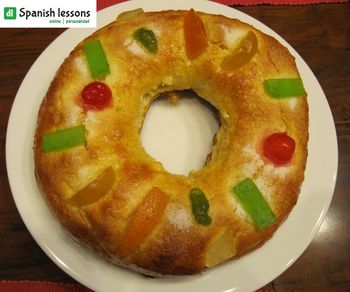PODCAST: read and listen to this entry at the same time (you can find the Spanish text here)
The Three Magi (also known as Three Kings or Three Wise Men) is the holiday that marks the end of the Christmas season. It’s celebrated on January 5 and 6.
On the 5th of January we celebrate the night of the Three Magi. In the afternoon of this day, there’s a big (1) parade which is called “Cabalgata de los Reyes Magos” and the 6th is a public holiday we usually spend with our families.
The night of the Three Magi: the “Cabalgata de los Reyes Magos”
In Spain, on the night of the Three Magi the Three Wise Men bring gifts for the children. This is a Christian tradition that is deeply rooted in Spain. Instead of Santa Claus or Father Christmas, it’s traditional for the Three Kings to bring presents for the children. The New Testament mentions Magi from the Orient that arrive to worship Jesus and bring him gold, frankincense and myrrh.
The parade of the Three Magi is celebrated in big cities as well as in the smallest towns. The procession brings the Three Magi to the town or city where everybody can watch them go past on their (2) floats.
The Three Kings are called Melchior, Caspar and Balthazar and they come from the Orient having followed the brightest star. During the parade, each King is usually on a float that’s accompanied by pages and other persons. From their floats, they toss candy and sweets to kids.
The parade doesn’t just consist of floats, but also music and dance groups. They perform along the route and they’re situated between the different floats.
In this video of the town hall of Madrid, you can see briefly what the parade was like in this city in 2019.
You can see the Three Kings, the royal mailmen and their
floats. Furthermore, you can see the performances and how candy is tossed to the spectators. Not all parades are the same size. The parade in Alcoy is the oldest one in Spain and took place for the first time in 1866. It’s quite small and traditional.
And after the parade… Three Kings’ Cake (el roscón)
After the parade, we usually go home and, depending on each family’s customs, either the presents are already waiting or they can be found on the 6th in the morning when we wake up. Attention! The children cannot forget to leave something to eat and drink for the Three Kings before going to watch the parade or before going to bed. Not only for the Kings, but also for the (3) camels. If not, they won’t receive any presents.
Once all the presents are unwrapped it’s time for dinner, either with the family or with friends. At the end of it, the Three Kings’ Cake is a must.

The (4) Three Kings’ Cake is a type of circular sponge cake that’s decorated with (5) candied fruit.
Inside, there are hidden little figures with a special meaning. Two of them are the most important ones: the king and the (6) broad bean. If you bite on something hard while eating the Three Kings’ Cake, that’s because you got one of those figures. If it’s a king, you are crowned as king of the evening. However, if what you got is a broad bean, you’ll have to pay for the Three Kings’ Cake.
The Three Kings’ Cake is traditionally eaten with delicious hot chocolate.
January 6: Epiphany (Three Kings’ Day)
This is the last day of the Christmas season. If it’s a tradition in your family, you’ll find all the presents the Three Kings left for you the night before. This is a day spent with your family, too. If there’s some Three Kings’ Cake left, you have it for breakfast, and the children can play with their toys the rest of the day.
It’s the last day of the Christmas holidays. On the next day, the daily routine starts once again.
VOcabulary
- parade: cabalgata; desfile de personas con carrozas, música y bailes.
- float: carroza; vehículo adornado y decorada para un desfile, donde las personas van subidas en él.
- camel: camello; animal originario de Asia.
- Three Kings’ Cake: roscón; bizcocho redondo con un agujero en el centro.
- candied fruit: fruta confitada; fruta hecha en un baño de azúcar.
- broad bean: haba; legumbre de color verde muy común para hacer estofados.
Credits:
Featured image: dl Spanish lessons
Picture 01: dl Spanish lessons
